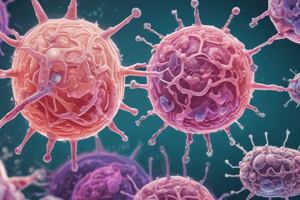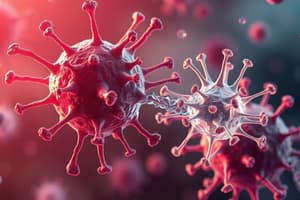Podcast
Questions and Answers
What are the four bordetella species we discussed in class?
What are the four bordetella species we discussed in class?
B. Pertussis (humans) ,B. Bronchiseptica, B. Adium and B. Parapertussis
Which of the following best describes the Gram reaction and morphology of Bordetella spp.?
Which of the following best describes the Gram reaction and morphology of Bordetella spp.?
What is the oxygen requirement of Bordetella spp?
What is the oxygen requirement of Bordetella spp?
They are strict aerobes
Bordetella spp. primarily colonize which of the following anatomical sites?
Bordetella spp. primarily colonize which of the following anatomical sites?
Signup and view all the answers
Bordetella spp are normal inhabitants of the upper respiratory tract and survive poorly in the environment (except B. Parapertussis)
Bordetella spp are normal inhabitants of the upper respiratory tract and survive poorly in the environment (except B. Parapertussis)
Signup and view all the answers
Which Bordetella species is known for its ability to survive in the environment better than others?
Which Bordetella species is known for its ability to survive in the environment better than others?
Signup and view all the answers
Bordetella spp are opportunistic pathogens
Bordetella spp are opportunistic pathogens
Signup and view all the answers
What is the primary mode of transmission for Bordetella spp?
What is the primary mode of transmission for Bordetella spp?
Signup and view all the answers
Which group of animals is particularly susceptible to Bordetella infections?
Which group of animals is particularly susceptible to Bordetella infections?
Signup and view all the answers
What are the typical C.S. With bordetella spp?
What are the typical C.S. With bordetella spp?
Signup and view all the answers
What respiratory diseases can cause these clinical signs? (Hint: 4)
What respiratory diseases can cause these clinical signs? (Hint: 4)
Signup and view all the answers
Bordetella spp. typically cause respiratory infections with what characteristics?
Bordetella spp. typically cause respiratory infections with what characteristics?
Signup and view all the answers
Which of the following virulence factors is primarily responsible for Bordetella spp. adherence to host ciliated epithelial cells?
Which of the following virulence factors is primarily responsible for Bordetella spp. adherence to host ciliated epithelial cells?
Signup and view all the answers
How do the virulence factors of Bordetella spp. contribute to its pathogenesis?
How do the virulence factors of Bordetella spp. contribute to its pathogenesis?
Signup and view all the answers
What is the function of the Bordetella virulence gene (bvg) locus?
What is the function of the Bordetella virulence gene (bvg) locus?
Signup and view all the answers
At what temperature does Bordetella spp. enter its virulent (Bvg+) phase?
At what temperature does Bordetella spp. enter its virulent (Bvg+) phase?
Signup and view all the answers
The bordetella virulence gene (bvg) locus turns off at ___
The bordetella virulence gene (bvg) locus turns off at ___
Signup and view all the answers
Match each Bvg phase to its correct description:
Match each Bvg phase to its correct description:
Signup and view all the answers
The predilection site for Bordetella spp is _____
The predilection site for Bordetella spp is _____
Signup and view all the answers
Which of the following best describes how Bordetella bronchiseptica establishes persistent colonization in its hosts?
Which of the following best describes how Bordetella bronchiseptica establishes persistent colonization in its hosts?
Signup and view all the answers
Who are the hosts of B. Bronchiseptica?
Who are the hosts of B. Bronchiseptica?
Signup and view all the answers
B. Bronchiseptica’s site of infection is the lower respiratory tract
B. Bronchiseptica’s site of infection is the lower respiratory tract
Signup and view all the answers
What is the primary mechanism by which Bordetella bronchiseptica modifies the adaptive immune response?
What is the primary mechanism by which Bordetella bronchiseptica modifies the adaptive immune response?
Signup and view all the answers
B. Bronchiseptica in pigs causes _____
B. Bronchiseptica in pigs causes _____
Signup and view all the answers
Which of the following statements accurately reflects the pathogenesis of B. bronchiseptica infection in pigs, leading to turbinate atrophy?
Which of the following statements accurately reflects the pathogenesis of B. bronchiseptica infection in pigs, leading to turbinate atrophy?
Signup and view all the answers
The development of turbinate atrophy in pigs infected with B. bronchiseptica is influenced by the presence of ____
The development of turbinate atrophy in pigs infected with B. bronchiseptica is influenced by the presence of ____
Signup and view all the answers
Dermonecrotic toxin damages osteoclasts, preventing bone formation
Dermonecrotic toxin damages osteoclasts, preventing bone formation
Signup and view all the answers
Flashcards
Bordetella species
Bordetella species
B. Pertussis, B. Bronchiseptica, B. Avium, B. Parapertussis
Gram reaction of Bordetella
Gram reaction of Bordetella
They are Gram-negative rods or coccobacilli.
Oxygen requirement of Bordetella
Oxygen requirement of Bordetella
Bordetella species are strict aerobes.
Colonization site of Bordetella
Colonization site of Bordetella
Signup and view all the flashcards
Bordetella environmental survival
Bordetella environmental survival
Signup and view all the flashcards
Bordetella avium
Bordetella avium
Signup and view all the flashcards
Pathogenic nature of Bordetella
Pathogenic nature of Bordetella
Signup and view all the flashcards
Transmission of Bordetella spp.
Transmission of Bordetella spp.
Signup and view all the flashcards
Susceptible animals
Susceptible animals
Signup and view all the flashcards
Symptoms of Bordetella infections
Symptoms of Bordetella infections
Signup and view all the flashcards
Respiratory diseases from Bordetella
Respiratory diseases from Bordetella
Signup and view all the flashcards
Characteristics of Bordetella infections
Characteristics of Bordetella infections
Signup and view all the flashcards
Bordetella virulence factor
Bordetella virulence factor
Signup and view all the flashcards
Pathogenesis of Bordetella spp.
Pathogenesis of Bordetella spp.
Signup and view all the flashcards
Persistent colonization of B. Bronchiseptica
Persistent colonization of B. Bronchiseptica
Signup and view all the flashcards
Macrophage modulation by B. Bronchiseptica
Macrophage modulation by B. Bronchiseptica
Signup and view all the flashcards
Dendritic cell function in B. Bronchiseptica
Dendritic cell function in B. Bronchiseptica
Signup and view all the flashcards
Adaptive immune response adjustment
Adaptive immune response adjustment
Signup and view all the flashcards
Consequences of immune modulation
Consequences of immune modulation
Signup and view all the flashcards
Site of B. Bronchiseptica infection
Site of B. Bronchiseptica infection
Signup and view all the flashcards
Pathogenesis of atrophic rhinitis
Pathogenesis of atrophic rhinitis
Signup and view all the flashcards
Two forms of atrophic rhinitis
Two forms of atrophic rhinitis
Signup and view all the flashcards
Factors increasing infection incidence
Factors increasing infection incidence
Signup and view all the flashcards
Treatment for B. Bronchiseptica
Treatment for B. Bronchiseptica
Signup and view all the flashcards
Study Notes
Persistent Colonization in Bordetella bronchiseptica
- Bordetella bronchiseptica persistently colonizes, particularly in the nasopharynx of pigs.
- This persistence is linked to its ability to modify macrophage and dendritic cell function, thereby influencing the adaptive immune response.
- Colonization often occurs during the first few weeks of life in pigs.
Modulation of Macrophage and Dendritic Cell Function
- B. bronchiseptica manipulates macrophage and dendritic cell function, possibly altering antigen presentation and cytokine production.
- This manipulation likely plays a role in the organism's persistence.
- Modified antigen presentation could weaken the subsequent adaptive immune response.
Impact on Adaptive Immune Response
- Altered macrophage and dendritic cell function results in a less effective adaptive immune response.
- This reduced efficacy contributes to the organism's persistent colonization, leading to diseases like bronchopneumonia and atrophic rhinitis.
- Atrophic rhinitis in pigs includes both progressive (with Pasteurella multocida) and non-progressive (with B. bronchiseptica alone) forms. Non-progressive atrophic rhinitis might resolve without complications.
Potential Mechanisms of Modulation
- B. bronchiseptica may produce factors directly inhibiting macrophage activation.
- Alternatively, the bacteria might indirectly modulate macrophages by altering the local environment.
- Further research is needed to fully understand the mechanisms.
Pig-Specific Observations
- B. bronchiseptica infection often occurs in the nasopharynx and can lead to complications like atrophic rhinitis, characterized by turbinate atrophy (without distortion) in uncomplicated cases.
- Dermonecrotic toxin produced by the bacteria damages osteoblasts, hindering bone formation and potentially causing snout malformations.
- High stocking density and poor ventilation increase the incidence of infection.
- Treatment includes vaccination, antibiotics, and improved management practices.
Studying That Suits You
Use AI to generate personalized quizzes and flashcards to suit your learning preferences.
Description
Know the Bordetella spp of veterinary importance, characteristics, pathogenesis etc



